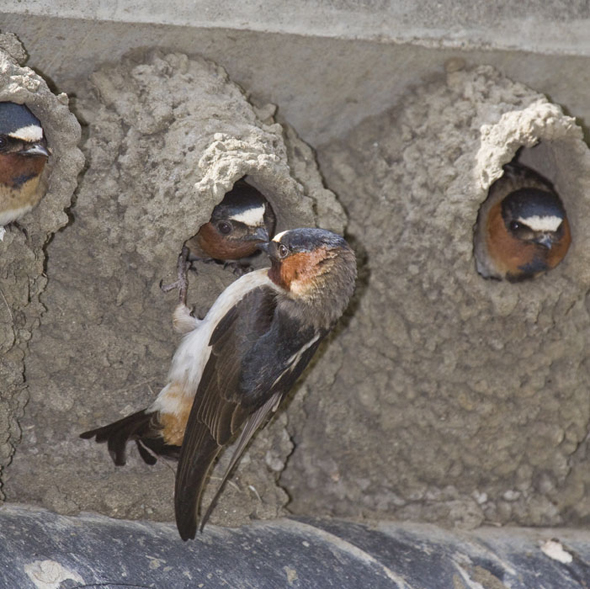
Cliff swallows (Petrochelidon pyrrhonata) in Cayucos, CA. Photo courtesy of Wikimedia Commons and Marlin Harms.
Swallows evolve shorter wings to avoid cars, study suggests.
Over the past few years, I’ve grown increasingly skeptical of such headlines. Still, sometimes the research really does live up to the media hype. This would seem to be the case here, in an NBC News story about the recently published work of Charles Brown and Mary Bomberger Brown.
Collecting and studying the “salvageable specimens” of cliff swallows killed along the roads surrounding southwestern Nebraska’s Cedar Point Biological Station over the past 30 years, Brown and Brown found the numbers of road-killed birds “declined sharply.” [1] And the trend couldn’t be explained by the population of swallows living nearby (which increased over the study period), traffic volume (which “either did not change significantly or increased, depending on the metric used”), or the number of avian scavengers in the area (“as none showed significant increases in our study area”).
“Thus, none of the obvious factors that confound most road-kill surveys applied to our study,” explain the researchers in the most recent issue of Current Biology. [1]
So why the decrease in swallow mortalities?
The answer seems to be evolution: the swallows being killed by cars had, on average, significantly longer wings than the general population.
“Longer wings have lower wing loading and do not allow as vertical a take-off as shorter, more rounded wings,” report the researchers. “Thus, individuals sitting on a road, as cliff swallows often do, who are able to fly upward more vertically may be better able to avoid or more effectively pivot away from an oncoming vehicle.” [1]
“I don’t think necessarily road mortality is the sole cause of this,” Charles told NBC. “I think there are other factors that may be leading to this, but the point is, I think that for whatever reasons, these animals can adapt very rapidly to these urban environments and they can avoid being killed.” [2]
That’s the part of the story that got my attention: very rapid adaptation. TNR opponents sometimes argue that because the domestic cat did not evolve alongside many of the prey species found in this country, they have a distinct advantage. [3–5] But if cliff swallows can evolve shorter wings to adapt to the hazards of living under bridges and overpasses—over a span of just 30 years—then why not adaptations to avoid other hazards, too?
It’s too soon to say, obviously—but in light of these findings, the idea doesn’t seem all that far-fetched either.
Literature Cited
1. Brown, C.R. and Bomberger Brown, M., “Where has all the road kill gone?“ Current Biology. 2013. 23(6): p. R233–R234. http://www.sciencedirect.com/science/article/pii/S0960982213001942
2. Roach, J. (2013) Swallows evolve shorter wings to avoid cars, study suggests. http://science.nbcnews.com/_news/2013/03/18/17358863-swallows-evolve-shorter-wings-to-avoid-cars-study-suggests
3. Jessup, D.A., “The welfare of feral cats and wildlife.” Journal of the American Veterinary Medical Association. 2004. 225(9): p. 1377–1383. http://www.ncbi.nlm.nih.gov/pubmed/15552312
http://www.avma.org/avmacollections/feral_cats/javma_225_9_1377.pdf
4. Winter, L. and Wallace, G.E., Impacts of Feral and Free-Ranging Cats on Bird Species of Conservation Concern, G.E. Wallace, Editor. 2006, American Bird Conservancy. www.abcbirds.org/newsandreports/NFWF.pdf
5. Holzman, S., Personal communication, 2011. (Recipients: Kathy Mooneyham, then director of DeKalb County (GA) Animal Services, and the DeKalb Board of Commissioners.)
